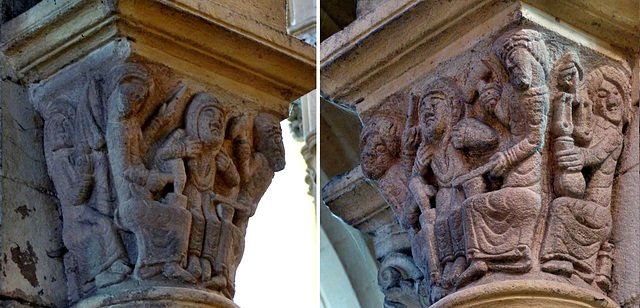Location
See also...
Keywords
Authorizations, license
-
Visible by: Everyone -
All rights reserved
-
196 visits
Souvigny - Prieuré Saint-Pierre-et-Saint-Paul


In 915 Aymar de Bourbon, ancestor of the House of Bourbon, gave land in Souvigny to the Cluny Abbey for the construction of a monastery. At that time the "Abbaye de Cluny" was just 5 years old, as it had been founded 910 by William I, Duke of Aquitaine, (aka "William the Pious").
Souvigny was one of the first priories, dependent from the Cluny Abbey, so it was known later as "one of the five eldest daughters of Cluny".
Cluny developed into the most powerful abbey in the Middle Ages, when the Cluniac Reforms changed the monastic life in Europe. German historian Dr. Joachim Wollasch ("Cluny, Licht der Welt"), estimates that in its haydays, more than 10.000 monks were parts of this network´, that stretched all over Europe. The pelerinage to Santiago de Compostella was one of the great "themes", developed and strongly supported by Cluny.
The priory in Souvigny, located about 130kms west of Cluny, was such an important convent, that two of the powerful abbots of Cluny, Majolus (+ 994) and Odilo (+ 1049) died here. Their graves were a place of pilgrimage site soon after. To cope with the growing number of pilgrims, the priory´s church got enlarged already within the 10th century.
Mayeul (= Majolus) was the 4th, Odilon (= Odilo) was the 5th abbot of the Abbey of Cluny. Odilo "invented" and established the "All Souls' Day" (2. November), that was adopted in the whole Western church.
The church, probably built after the model of Cluny III, with five aisles structure and two transepts, crumbled, when the times got tougher in the next centuries. A renovation was done in the 15th century, but the interior structure is still "clearly" Romanesque. It got recently renovated.
In 1793 French revolutionaries raged here with furor, destroyed the tombs and beheaded the sculptures, they believed to be connected to the Pope, Abbots or Bourbons.
They did not touch (most of) the capitals.
Another workshop has created this capital (see previous uploads), that for me is very mysterious. The person in the center is flanked by people holding tools. I can see a spindle (?), two hammers and a scale.
Souvigny was one of the first priories, dependent from the Cluny Abbey, so it was known later as "one of the five eldest daughters of Cluny".
Cluny developed into the most powerful abbey in the Middle Ages, when the Cluniac Reforms changed the monastic life in Europe. German historian Dr. Joachim Wollasch ("Cluny, Licht der Welt"), estimates that in its haydays, more than 10.000 monks were parts of this network´, that stretched all over Europe. The pelerinage to Santiago de Compostella was one of the great "themes", developed and strongly supported by Cluny.
The priory in Souvigny, located about 130kms west of Cluny, was such an important convent, that two of the powerful abbots of Cluny, Majolus (+ 994) and Odilo (+ 1049) died here. Their graves were a place of pilgrimage site soon after. To cope with the growing number of pilgrims, the priory´s church got enlarged already within the 10th century.
Mayeul (= Majolus) was the 4th, Odilon (= Odilo) was the 5th abbot of the Abbey of Cluny. Odilo "invented" and established the "All Souls' Day" (2. November), that was adopted in the whole Western church.
The church, probably built after the model of Cluny III, with five aisles structure and two transepts, crumbled, when the times got tougher in the next centuries. A renovation was done in the 15th century, but the interior structure is still "clearly" Romanesque. It got recently renovated.
In 1793 French revolutionaries raged here with furor, destroyed the tombs and beheaded the sculptures, they believed to be connected to the Pope, Abbots or Bourbons.
They did not touch (most of) the capitals.
Another workshop has created this capital (see previous uploads), that for me is very mysterious. The person in the center is flanked by people holding tools. I can see a spindle (?), two hammers and a scale.
aNNa schramm has particularly liked this photo
- Keyboard shortcuts:
Jump to top
RSS feed- Latest comments - Subscribe to the comment feeds of this photo
- ipernity © 2007-2024
- Help & Contact
|
Club news
|
About ipernity
|
History |
ipernity Club & Prices |
Guide of good conduct
Donate | Group guidelines | Privacy policy | Terms of use | Statutes | In memoria -
Facebook
Twitter

Sign-in to write a comment.